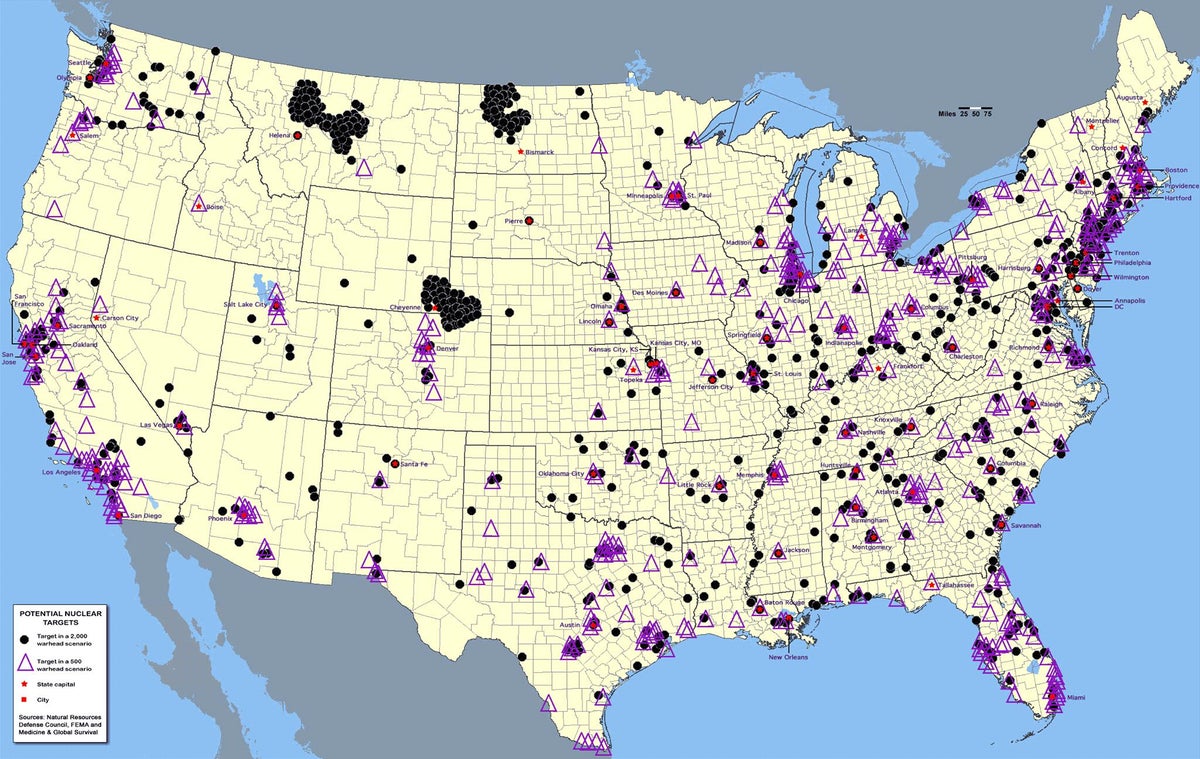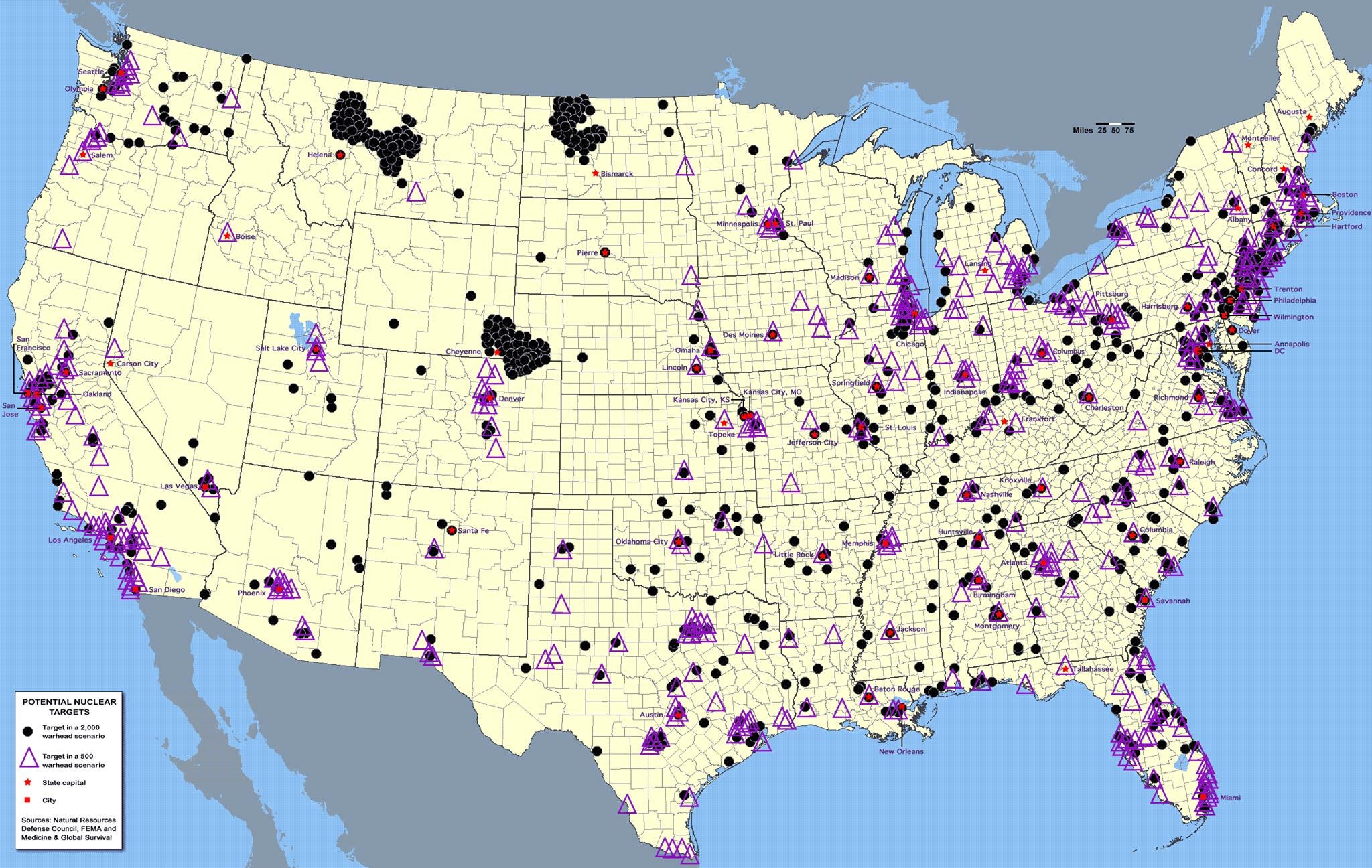
A map claiming to show the areas of the US that may be targeted in a nuclear war that originally circulated in 2015 is making the rounds again, amid the Russian war in Ukraine.
The map indicates that areas such as Montana and North Dakota may be vital to strike US forces.
The map outlines possible targets in every US state, mostly located in the east, but also along the Californian coast.
In the west, Colorado, Montana, North Dakota and Wyoming have clusters of targets noted on the map.
Some of the larger targets include active nuclear plants. There are approximately 90 plants across the US, with some located in Alabama, Arizona, Maryland, New Jersey, Pennsylvania, and Tennessee.
Areas of rural Idaho, Maine, Northern California, as well as Oregon may be more improbable targets.
The US has placed its nuclear forces away from areas with high populations.
Intercontinental ballistic missile silos (ICBMs), military bases, and nuclear storage are spread out across the US.

The map appears to date back to an article from US broadcaster CBS in 2015. It claims to have used data from the Federal Emergency Management Administration (FEMA), Medicine and Global Survival, and the National Resources Defense Council. FEMA, however, has distanced itself from the map. A spokesperson for the organisation said: “FEMA does not, and has not, released any type of formal map of potential nuclear targets. However, FEMA provides information to the public to help them prepare for a potential hazardous or radiological event through Ready.gov.”
Irwin Redlener at Columbia University specialises in disaster preparedness and notes that there are six cities in the US that are more likely to be targeted in a nuclear attack – New York, Chicago, Houston, Los Angeles, San Francisco and Washington DC.
The cities have infrastructure considered to be vital to the workings of the country, such as financial centres, government agencies and energy plants.
Other possible targets include Dallas-Fort Worth, Miami, and Philadelphia.
Last month, the State Department noted that Russia isn’t adhering to the last active nuclear arms agreement with the US, which was renewed in 2021. Russia responded by rejecting the claims and accusing the US of not following the agreement.
Late in 2022, Russian President Vladimir Putin threatened to use nuclear weapons not just in Ukraine.
He claimed that the West was employing “nuclear blackmail” and said Russia has “various means of destruction” in a threat directed at the US and Europe.
“To defend Russia and our people, we doubtlessly will use all weapons resources at our disposal,” he said. “This is not a bluff.”
Mr Putin said in December that Russia may change its policy of not being the first to use nuclear arms in a military conflict.
“They have it in their strategy, in the documents it is spelt out — a preventive blow. We don’t. We, on the other hand, have formulated a retaliatory strike in our strategy,” Mr Putin during a press conference, referring to the US and Russia, according to CNN.
“So if we’re talking about this disarming strike, then maybe think about adopting the best practices of our American partners and their ideas for ensuring their security. We’re just thinking about it. No one was shy when they talked about it out loud in previous times and years,” he said.
“If a potential adversary believes it is possible to use the theory of a preventive strike, and we do not, then this still makes us think about those threats that are posed to us,” he added.
“As for the idea that Russia wouldn’t use such weapons first under any circumstances, then it means we wouldn’t be able to be the second to use them either — because the possibility to do so in case of an attack on our territory would be very limited,” he said.
“We are not just fighting with Ukraine, but with the collective West,” Russian Defence Minister Sergei Shoigu said.
“Raising the alert of Russian nuclear forces is a bone-chilling development,” UN Secretary-General António Guterres said last year.
This article was amended on February 10 2023. It originally stated that the map was issued by FEMA, but that was incorrect. The original CBS article claims the map was produced using information from FEMA as well as from other sources.







